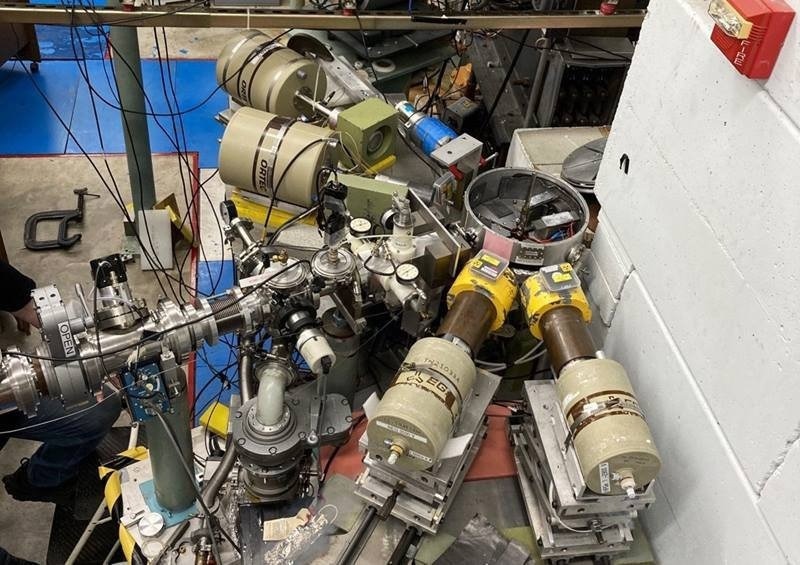Large, low-background detectors with xenon as a target medium are commonly utilized in fundamental physics investigations, notably those looking for dark matter or examining rare decays of atomic nuclei. In these detectors, a weak interaction between a neutral particle, such as a neutrino, and a xenon-136 nucleus can convert it into a cesium-136 nucleus in a highly excited state. The gamma rays released as cesium-136 relaxes from its excited state should help scientists distinguish unusual signals from background radioactivity.
 Photo of the experimental setup showing four high-purity germanium detectors surrounding the target chamber at the end of the Triangle Universities Nuclear Laboratory beamline. Image Credit: S.W. Finch.
Photo of the experimental setup showing four high-purity germanium detectors surrounding the target chamber at the end of the Triangle Universities Nuclear Laboratory beamline. Image Credit: S.W. Finch.
This might lead to new observations of solar neutrinos and more powerful searches for certain theories of dark matter. However, looking for these occurrences has been challenging due to a scarcity of good nuclear data for cesium-136. Researchers need to understand the characteristics of cesium-136 excited states, which have never been detected for this isotope.
The Impact
This novel study uses gamma-ray emission from cesium-136 generated in nuclear reactions in a particle accelerator to directly determine the pertinent facts. The discovery of so-called “isomeric states”—excited states that last for around 100 ns before relaxing to the ground state—by this research is significant.
The delayed emission of gamma rays from these states will manifest as a different signal from the first response in contemporary particle physics studies. This produces a distinct signal in the data that enables scientists to clearly detect these types of uncommon interactions and reject background noise.
Summary
Using the tandem accelerator at the Triangle Universities Nuclear Laboratory (TUNL), a group of scientists from Lawrence Berkeley National Laboratory, the SLAC National Accelerator Laboratory, the University of North Carolina - Wilmington, and Duke University have made new measurements of the excited states in cesium-136. The excited cesium-136 was produced by the researchers by subjecting a target of xenon-136 gas to a pulsed proton beam.
Using four high-purity germanium detectors encircling the target, they were able to detect the subsequent gamma-ray emission. The scientists were able to quantify the lifetimes of the excited states involved in the gamma-ray emission as well as reconstruct the level structure of the cesium-136 nucleus by measuring the energy of the gamma rays and their detection timings in relation to the beam pulse. Nuclear isomers with durations of 95 and 157 nanoseconds are discovered as two of the excited states.
With the use of these data, scientists can now accurately simulate the gamma-ray emission from large-scale xenon detectors that is caused by nuclear interactions known as "charged-current" for the first time. This offers a new avenue for the search for potential dark matter candidates and astrophysical neutrinos.
LZ, XENONnT, and KAMLAND-Zen are a handful of the large-scale ongoing projects that might begin to search for these occurrences right now in their data. With additional xenon-136, next-generation experiments like nEXO or XLZD could be especially sensitive to low-energy parts of the solar neutrino spectrum such as neutrinos from the carbon-nitrogen-oxygen (CNO) cycle.
Department of Energy Office of Science, Nuclear Physics program provided funding for this study.
Journal Reference:
Haselschwardt, S. J., et. al. (2023) Observation of Low-Lying Isomeric States in 136Cs: A New Avenue for Dark Matter and Solar Neutrino Detection in Xenon Detectors. Physical Review Letters. doi:10.1103/physrevlett.131.052502